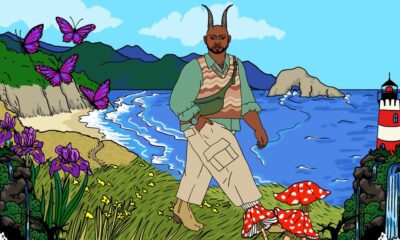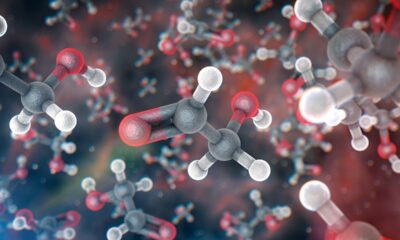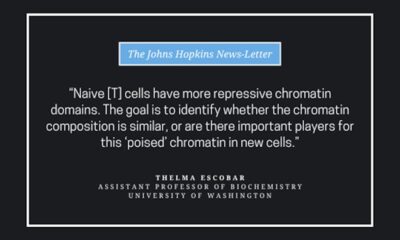Science
New Organic Compounds Found on Enceladus Boost Life Potential

Recent analysis of data from the Cassini space probe has unveiled new organic compounds in the icy jets of Enceladus, one of Saturn’s moons. This discovery, which suggests that Enceladus may possess the essential ingredients for life, expands upon the findings from Cassini’s mission, which concluded in 2017.
An international team of scientists, led by Fabian Klenner from the University of Washington, published their findings on October 1, 2023, in the journal Nature Astronomy. The research indicates that organic materials detected in the moon’s plumes likely originated from its vast underground ocean. Klenner stated, “We found a rich organic inventory in Enceladus’ plume. Having clear evidence of a variety of organic compounds from inside an extraterrestrial water world is incredible and further strengthens Enceladus’ potential for habitability.”
The Cassini probe, launched in 1997, spent years orbiting Saturn and conducting flybys of Enceladus. It played a crucial role in solving mysteries related to the moon and its environment, including the origins of Saturn’s faint E ring and the reasons behind Enceladus’ unusual brightness. The probe revealed that the moon is encased in a thick layer of reflective ice, under which lies a global ocean of saltwater. It also observed fissures in the moon’s surface, known as the South Polar Terrain, which eject icy water into space, contributing to the E ring.
Previously, data from Cassini’s Cosmic Dust Analyzer (CDA) led to the identification of organic compounds in the E ring. The probe’s findings suggested the presence of hydrothermal activity beneath the moon’s icy crust, potentially similar to conditions where life originated on Earth. Nozair Khawaja, the lead author and a research group leader at Freie Universität Berlin, noted, “We suspect that so-called hydrothermal fields exist there — these are vents at the bottom of the ocean from which hot water rises.”
The recent analysis focused on material collected during a close flyby of Enceladus’ icy plume, providing scientists with a glimpse of the compounds just moments after they were expelled from the moon. “The high-speed flyby of Enceladus enabled us to identify new compounds that were not found in the E ring data, most notably esters, alkenes, and ether compounds,” Klenner explained. These compounds, particularly esters and ethers, are crucial as they can form lipids, fundamental components of cellular life.
The success of the Cassini mission has inspired significant investment in future exploratory missions in the outer solar system. The NASA mission to study Europa, a moon of Jupiter, is currently underway, furthering the search for extraterrestrial life.
Despite the conclusion of the Cassini mission, opportunities to analyze its data remain abundant. Klenner expressed enthusiasm for the potential discoveries still hidden within the CDA data, stating, “It’s phenomenal to continue learning from the Cassini mission. Much of the CDA data still isn’t analyzed and I’m so excited about what it may reveal next.”
The research involved contributions from several institutions and was funded by the European Research Council, the German Aerospace Center, the state of Berlin, and NASA.
For further inquiries, Klenner can be contacted at [email protected]. This article has been adapted from a press release issued by the University of Stuttgart.
-

 Technology5 months ago
Technology5 months agoDiscover the Top 10 Calorie Counting Apps of 2025
-

 Health3 months ago
Health3 months agoBella Hadid Shares Health Update After Treatment for Lyme Disease
-

 Health3 months ago
Health3 months agoErin Bates Shares Recovery Update Following Sepsis Complications
-

 Technology4 months ago
Technology4 months agoDiscover How to Reverse Image Search Using ChatGPT Effortlessly
-

 Technology1 month ago
Technology1 month agoDiscover 2025’s Top GPUs for Exceptional 4K Gaming Performance
-

 Technology3 months ago
Technology3 months agoElectric Moto Influencer Surronster Arrested in Tijuana
-

 Technology5 months ago
Technology5 months agoMeta Initiates $60B AI Data Center Expansion, Starting in Ohio
-

 Technology5 months ago
Technology5 months agoRecovering a Suspended TikTok Account: A Step-by-Step Guide
-

 Health5 months ago
Health5 months agoTested: Rab Firewall Mountain Jacket Survives Harsh Conditions
-

 Lifestyle5 months ago
Lifestyle5 months agoBelton Family Reunites After Daughter Survives Hill Country Floods
-

 Health3 months ago
Health3 months agoAnalysts Project Stronger Growth for Apple’s iPhone 17 Lineup
-

 Technology4 months ago
Technology4 months agoHarmonic Launches AI Chatbot App to Transform Mathematical Reasoning





















